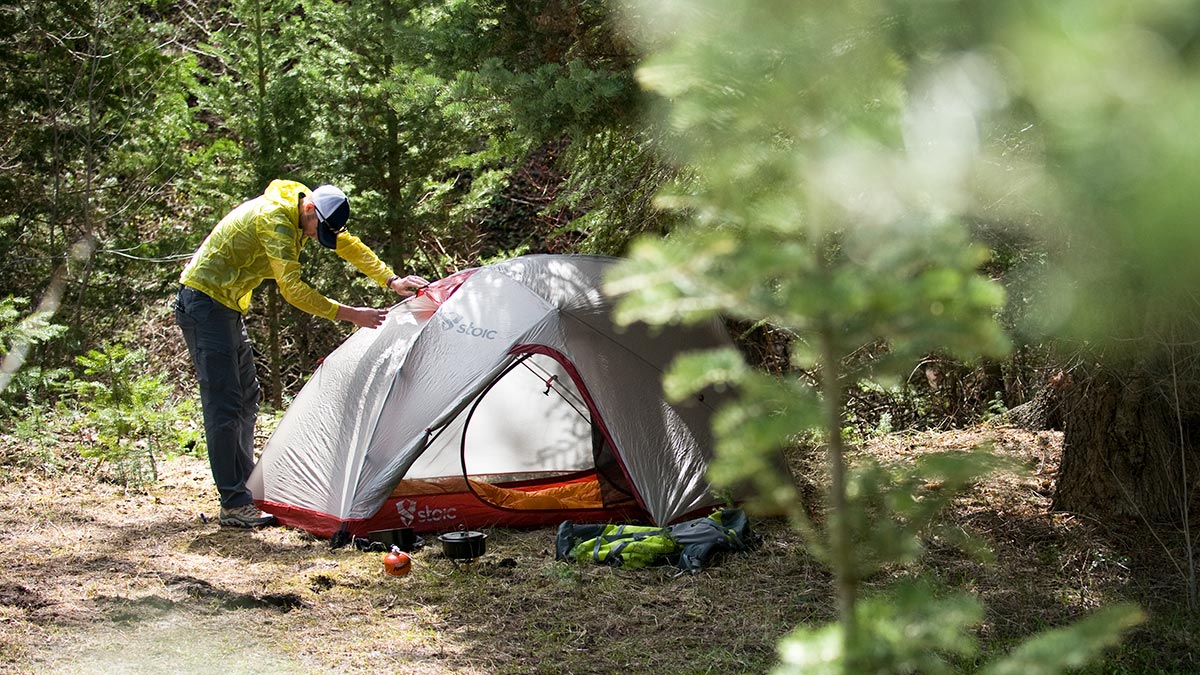
Ground Surface
Where you choose to sleep will be an important decision when picking a campsite. It’s crucial to pick a spot with flat, well drained ground to pitch a tent.
Shade
After flat ground, shade is the second most important factor when choosing a campsite. Having permanent shade throughout the day isn’t necessarily mandatory. But shade in the at the right time of day is nice. Being awoken at 7 a.m. by a blazing hot sun broiling your tent is unpleasant in hot weather. At the same time, morning sun will dry tents and warm you up on cold mornings.
What’s Above You
For the sake of your own safety, always be aware of what’s looming above you. Don’t choose to set up beneath a dead tree branch with the reasoning that ‘it’s still standing, so it’s probably safe.’ Same goes for rock slide and avalanche paths, as well as pitching a tent beneath a loose rock ledge. Always be cautious of these sorts of hazards, because Mother Nature isn’t always forgiving.What’s Around You
Not only is it important to think about what’s above you, it’s also smart to note what’s surrounding you. You may not want to be camped right on the water’s edge due to bugs, thirsty animals, and flooding risk. But if you’re out there hauling your own water, it sure does help to be relatively close to a water source so you’re not breaking your back lugging precious water about. (*JR note: Rising water levels can be a hazard and running water noise can impair hearing things that you may need to hear. So within 100 yards of fresh water for convenience, but not too close.*)If your forecast notes high winds, consider settling down behind a windbreak such as large boulders or a stand of trees. Don’t be caught on the flat open ground during a windstorm—it’s not a pleasant experience.
Privacy
Although neighbors can be a good thing, you don’t always want another party 20 feet away from you. Finding yourself a little bit of privacy makes your camping experience all that much more enjoyable, and really highlights the excitement of getting out into the wilderness. This doesn’t mean you have to backpack in 10 miles, or four-wheel in for hours just to get away from everyone else (although this kind of privacy sometimes can’t be beat). It’s easy enough to get off the beaten path without overexerting yourself or your vehicle. So don’t settle for the first spot you see if it’s surrounded by other folks or too close to the trail. Go out and find yourself a new—and better—spot!Space
With ground surface, shade, and privacy settled on, it’s now time to discuss ample camping space. If you’re out backpacking and pitching a sole tent, there’s not as much of a need for a ton of space. Alternatively, if you’re with a larger party and lots of gear, you’ll need to find yourself a bigger spot. Tent space and kitchen space are obviously two of the most important spatial factors. But don’t cut corners if there’s fun and games to be had. Be sure to choose areas which allow for any activities you may have brought along. After all, just because you’re camping doesn’t mean you have to sacrifice all the comforts of home.
When choosing your own area for a campsite, it’s important to just keep in mind what exactly it is that you’re looking for. The number of people, dogs or no dogs, activities, trail access, nearby water sources—all of these will play into your perfect camping spot. So go out there and find yourself in nature—just be sure to be safe, have fun, and always leave the area just as clean as you found it.
Security
In a SHTF scenario, you want a camp sight that offers concealment and cover yet provides a look out point or points with the ability to see and hear what is coming from a distance. For large groups, set up camp in concentric rings, with the command post in the center. Have three (or more) outposts in a triangle (symmetric) shape that can see and provide cover fire for each other. An additional layer of outer security is good if you have the numbers to provide early engagement of intruders before they get to your camp, or to be behind them if they get through. A Scout or Patrol Team that is on the move provides an extra element of unpredictable security. The use of Night Vision and Intruder Detectors are recommended.Inspired by BoysLife.org: How to build a survival shelter
BAD PLACES TO BUILD A SHELTER
- Anywhere the ground is damp.
- On mountaintops and open ridges where you are exposed to cold wind.
- In the bottom of narrow valleys where cold collects at night.
- Ravines or washes where water runs when it rains or near water that might rise.
- Near dead trees or ones with dead limbs that can fall in high winds.
- By a single tree that towers above the rest that could serve as a lightning rod.
- Rocky ledges or below loose, boulder-strewn slopes where falling rocks or even a full-blown landslide, mudslide or avalanche could wipe you out.
Blog Table of Contents











